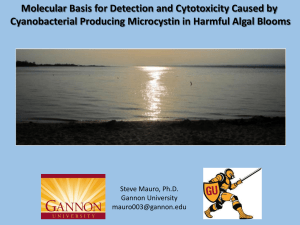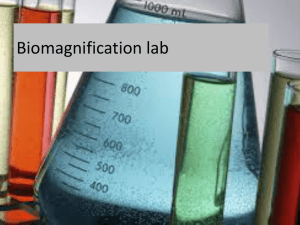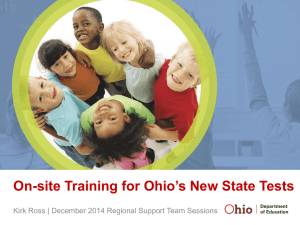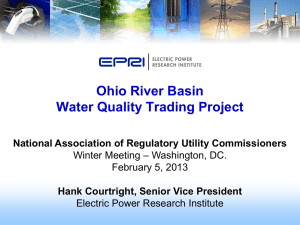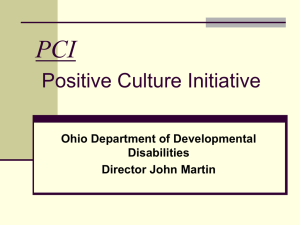Linda Merchant-Masonbrink, HABs the Ohio
advertisement
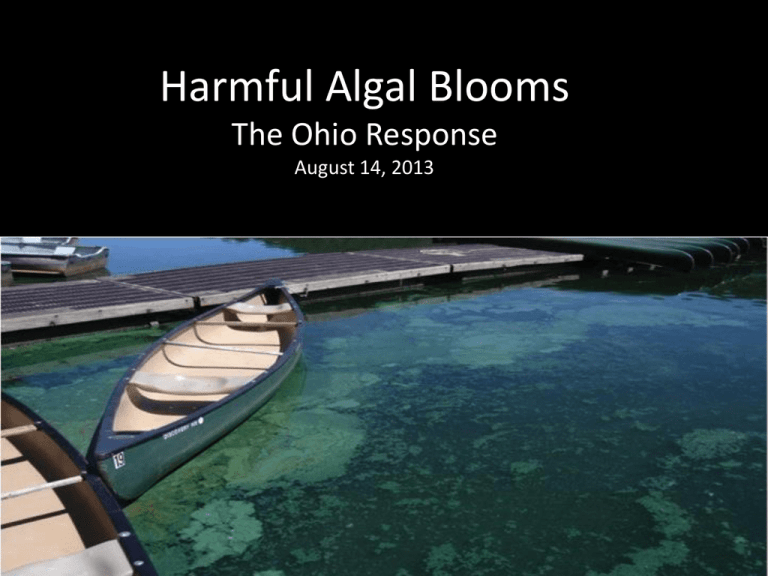
Harmful Algal Blooms The Ohio Response August 14, 2013 Today’s Discussion • • • • • • • • Developing Awareness Developing Coordinated State Effort Developing Recreational Response Strategy Developing Public Water Supply Response Strategy Developing Benchmark Criteria Developing Advisory Protocols Developing Sampling Strategies Developing Tracking Methods Developing Awareness 2007 National Lake Survey • Purpose – Compare lakes nationwide • 19 Ohio lakes randomly selected • First time Ohio EPA collected water samples for microcystin analysis • Microcystin results ranged from ND - 78 ppb. Summary of Microcystin Results from National Lake Survey • Nationwide, 30% of lakes had microcystin – (Ranging from ND to 230 ppb) • 7 of the 19 Ohio Lakes (36.8%) had detectable microcystin • 3 of Ohio lakes (10.5%) had levels > 1 ppb USEPA’s Concerns • According to USEPA, HABs are increasing in spatial and temporal prevalence in the US and worldwide. “Their highly potent toxins are a significant hazard for human health and ecosystem viability.” • Cyanobacteria and their toxins are on USEPA’s Office of Water Unregulated Contaminant Monitoring Regulation List 3 and Contaminant Candidate List. Comparative Toxicity - Highly Potent (AWWA Webcast) Compound LD50 (μg /kg) Compound LD50 (μg /kg) Saxitoxin 9 Ricin 0.02 Anatoxin-a(s) 20 Cobra Toxin 20 Microcystin LR 50 Curare 500 Anatoxin-a 50 Strychnine 2000 Toxin Reference Doses Dioxin (0.000001 mg/kg-d) Toxicity of Algal Toxins Relative to Other Toxic Compounds found in Water • Reference Dose = amount that can be ingested orally by a person, above which a toxic effect may occur, on a milligram per kilogram body weight per day basis. Microcystin LR (0.000003 mg/kg-d) Saxitoxin (0.000005 mg/kg-d) PCBs (0.00002 mg/kg-d) Cylindrospermopsin (0.00003 mg/kg-d) Methylmercury (0.0001 mg/kg-d) Anatoxin-A (0.0005 mg/kg-d) DDT (0.0005 mg/kg-d) Selenium (0.005 mg/kg-d) Botulinum toxin A (0.001 mg/kg-d) Alachlor (0.01 mg/kg-d) Cyanide (0.02 mg/kg-d) Atrazine (0.04 mg/kg-d) Fluoride (0.06 mg/kg-d) Chlorine (0.1 mg/kg-d) Aluminum (1 mg/kg-d) Ethylene Glycol (2 mg/kg-d) Ohio EPA’s Initial Response • 2007 - National Lake Survey • 2008 - Initiation of new Ohio EPA Inland Lakes Monitoring Program • 2008 - Formation of a Harmful Algal Bloom Workgroup and Initiative • 2009 - Microcystin results from National Lake Survey released. Sampling for microcystin at selected lakes 2010 Illnesses Reported Human illnesses reported to ODH in 2010 related to recreational algal toxin exposure 48 (probable and suspected) 8 9 6 3 2 1 19 Grand Lake St. Marys (and 3 dog deaths) Western Lake Erie Burr Oak State Park (and 2 dog deaths) Deer Creek Lake Alma Lake Hope Lake Mac-O-Chee (YMCA Camp Wilson) HAB STRATEGY Recreational Waters Why Develop a Strategy? –Need to protect the public (PWS users and recreational users) –Need for common definitions –Need for consistent sampling protocol –Need for thresholds that protect entire human population –Need for consistent advisory language –Need unified outreach strategy –Need for ODH/ODNR/OEPA to continue working together – Need for defined agency roles –Need for One-Stop Shop Guidance (from contacts to forms) State of Ohio Harmful Algal Bloom Response Strategy Recreational HAB Response Strategy http://www.epa.state.oh.us/dsw/HAB.aspx - or www.ohioalgaeinfo.com Contact - Linda Merchant-Masonbrink (Division of Surface Water) 614-644-2135 Ohio’s Recreational Strategy • First released June 2011. Revised April 2012. • ODH/OPEPA/ODNR Cooperative Effort • Sets recreational thresholds and sampling protocols. • Advisory system Response Program, Not Monitoring Program • Focus- State Park Lakes • Purpose- Protect Public Health World Health Organization vs Ohio Thresholds • There are no federal criteria for any cyanotoxin • WHO developed thresholds for microcystin only for a 60 kg adult • Adult threshold is 20 ppb for recreation and 1 ppb for drinking water. •Ohio determined thresholds for 4 toxins detected in Ohio: • Ohio recreational thresholds above are based on a 15 kg child. • Ohio drinking water thresholds are based on a 60 kg adult. Advisory Thresholds Microcystin * Anatoxin-a Cylindrospermopsin Saxitoxin* Recreational Public Health Advisory 6 80 5 0.8 Recreational No Contact Advisory** 20 300 20 3 Drinking Water: Do Not Drink Advisory 1 20 1 0.2 Drinking Water: Do Not Use Advisory 20 300 20 3 Type of Advisory *Microcystin and Saxitoxin thresholds are intended to be applied to total concentrations of all reported congeners of those toxins. **A No Contact Advisory is issued when toxin levels exceed the recommended threshold and there are one or more probable cases of human illness or pet deaths attributable to HABs. World Health Organization – Adult threshold is 20 ppb for recreation and 1 ppb for drinking water. The State of Ohio recreational thresholds are based on a 15 kg child. Agency Roles • Ohio Department of Natural Resources – – – – • Ohio Department of Health – – – – – • Monitor State Park lakes for HAB development Sample when blooms sighted in contact recreational areas Post advisories at State Park lakes Outreach Review illness reports and determine if related to algal toxins Determine advisory thresholds in consultation with ODNR and Ohio EPA Provide information to the public about safety Advise public about private lake HAB issues Outreach on health effects of HABs Ohio Environmental Protection Agency – – – – – – – – – – Maintain database of all state reported HAB data Maintain Ohioalgaeinfo.com for the State Maintain the interactive map of HAB advisories at public lakes Receive and review Bloom Reports and refer for follow-up Advise public about private lake HAB issues Assist with sampling at public lakes when needed Assist in algae ID Monitor and interpret satellite imagery Train others in sample collection Outreach Outreach and Cooperation • County Health Departments (Erie County Health Department posts their own advisories) • Veterinary Medical Association • Corps of Engineers (cooperate with Ohio DNR on lakes where they share a presence) • Beach Managers • Charter Boat Captains • Stone Laboratory Workshops 2012 General SignageState Park Lakes To protect the public from potential HABs in areas of state park lakes that are not monitored, signs with the following language may be posted at lake access points such as boat launch ramps and docks. Recreational Public Health AdvisoryState Park Lakes When cyanotoxin levels are equal to or exceed a Recreational Public Health Advisory threshold, whether or not a HAB is still present. WARNING No Contact Advisory – State Park Lakes When cyanotoxin levels are equal to or exceed the Recreational No Contact Advisory thresholds AND there are one or more probable cases of human illness or pet deaths attributable to cyanotoxins. DANGER SIGNAGE REMOVAL After two consecutive samples taken at least 1 week apart indicate cyanotoxin concentrations are below the threshold levels AND the bloom is gone. Beach Managers Guide Outline of Strategy sampling protocols for State Park Beach Managers PWS Response Strategy Public Water System HAB Response Strategy http://www.epa.ohio.gov/portals/28/docu ments/HAB/PWS-HAB-response.pdf Contact - Heather Raymond or Laura Webb (Division of Drinking and Groundwaters) 614-644-2752 Algal Toxin ThresholdsDrinking Water Threshold (ug/L) Microcystin** Anatoxin-a Cylindrospermopsin Saxitoxin** Do Not DrinkAll consumers 1 - 20 20 - 300 1 – 20 0.2 - 3 Do Not UseAll consumers* > 20 > 300 > 20 >3 * These are also the concentrations for recreational no-contact thresholds. ** Microcystin and saxitoxin thresholds are intended to be applied to total concentrations of all reported congeners of those toxins. Note: In 2012, the Minnesota Department of Health completed a toxicity review of microcystin-LR through their Contaminants of Emerging Concern program. Multiple-duration reference doses and drinking water values were derived. Drinking water guidance was set at 0.04 ppb, which was intended to be protective of a short-term exposure for bottle-fed infants. Ohio EPA PWS HAB Response Plan • Public water systems are not required to monitor for toxins, but monitoring is encouraged for systems with a history of HABs • Ohio EPA will respond to bloom reports using a tiered approach: – Observation – Screening – Toxin monitoring • Takes advantage of additional types of data that is available or may be obtained in coordination with PWS – Algae identification, cell count, chlorophyll a, water quality information, field test kits • Use bloom severity, proximity to intake and PWS treatment information to target algal toxin monitoring on drinking water sources most at risk Level 1 - Observation • Bloom identified through: – – – – PWS surveillance/changes in water quality HAB report via Ohio EPA website NOAA HAB satellite surveillance Ohio EPA water quality surveys • Work with PWS to investigate and characterize – – – – Ask PWS to inspect reservoir for visual evidence of a bloom Request PWS to submit Online Bloom Report Form Determine if treatment is being affected Evaluate changes in raw water quality • Determine if go to screening or toxin monitoring, or continue observation When to Move to Level 2 or 3 Determined case by case, after considering the following factors: • Bloom severity, location, and extent of reservoir affected • Likelihood of cyanobacterial cells or toxins being drawn into the intake: – Proximity of bloom to the intake – Depth of the intake – Wind/weather conditions • Treatment in Use (Conventional only or advanced) • Changes in raw water quality (e.g. taste and odor, turbidity or pH increases) • Reported human illness or animal deaths • Toxin screening data Determine Bloom Severity • Severe bloom (meets any of the following): – Cyanobacteria cell count > 100,000 cells/mL – Biovolume > 10 mm3/L – Chlorophyll a > 50 µg/L – Significant scum or surface accumulation is present and/or significant concentration of cells are visible throughout the water column • Moderate bloom (meets any of the following): – Cyanobacteria cell count 10,000-100,000 cells/mL – Biovolume 1-10 mm3/L – Chlorophyll a 5-50 µg/L (note: proposed lake habitat use impairment level is > 14 µg/L for all but Western Allegheny Plateau, which is > 6.2 µg/L) – Surface accumulation is present and/or bloom is visible throughout the water column • Minor bloom (meets any of the following): – Cyanobacteria cell count 4,000-10,000 cells/mL – Biovolume 0.4-1 mm3/L – Chlorophyll a 2-5 µg/L – Some visual evidence of a bloom Moving Between the Levels Bloom Severity Likelihood of Being Drawn into the Intake More likely Severe Less likely More likely Moderate Less likely More likely Minor Less likely Advanced Treatment Action not in use, or not working properly in use not in use, or not working properly in use not in use, or not working properly in use not in use, or not working properly in use not in use, or not working properly in use not in use, or not working properly in use Sample Toxins Sample Toxins Screen Screen Sample Toxins Screen Screen Observe Screen Observe Observe Observe Level 2 - Screening • Request PWS to assess the conditions in their source waters • Screening options include: – Phytoplankton analysis: identification of cyanobacteria genera present and cell count or biomass information – Field test kits for algal toxin analysis: quick tube or strip kits that provide an indication of presence or absence of microcystin • Determine whether to conduct additional screening, proceed to algal toxin monitoring, or return to observation Level 3 - Toxin Monitoring • For PWS that conduct their own monitoring, Ohio EPA requests they submit the results to Ohio EPA so duplicative sampling isn’t necessary. • Data from sampling conducted by the PWS will be posted on Ohio EPA’s website only with the agreement of the PWS. • Provide algal toxin sampling supplies to PWSs with history of HABs. • If PWSs do not conduct their own monitoring and it is determined necessary, Ohio EPA DDAGW district staff will collect samples for toxin analysis. Resources-Drinking Water • Guidance to assist PWSs: Bloom identification and characterization guide Algaecide application fact sheet Reservoir management strategies fact sheet Screening tools: cell counts/biovolume, test kits HAB Response Strategy: thresholds and response protocol Laboratory and test kit list HAB Report Form Resources and references www.epa.state.oh.us/ddagw/hab.aspx • AWWA Technology Committee white paper on treatment options for water systems TRACKING Difficulty Tracking HABs and Toxins • Blooms are transient • Blooms not always visible or may look like turbidity • Not all cyanobacteria produce toxins, and those that do, don’t produce the toxin all the time • Many cyanobacteria produce multiple toxins • Reason for toxin production unknown • Toxins persist NOAA processed satellite imagery Lake Erie - September 12, 2010 Satellite Imagery of Inland Lakes (MERIS) DEFIANCE HENRY WOOD "/!R "/ !R !R!R !R "/ PAULDING !R !R !R!R"/ PUTNAM !R !R HANCOCK !R !R !R!R !R !R !R LAKE !R VAN WERT ! "/ !R"/R ! "/ "/R !R "/ "/"/ "/"/ "/ ! !RR "/ ASHTABULA "/ ""/"/ "/"/ / GEAUGA "/ "/ "/"/ CUYAHOGA ALLEN !R !R !R !R !R !R!R!R LORAIN TRUMBULL "/!R !R HARDIN !R MERCER !R !R! R "/ AUGLAIZE MEDINA !R PORTAGE "/!R !R SUMMIT "/ "/"/ "/ "/ !R !R MAHONING "/ "/ !R !R !R "/ !R LOGAN "/ !R "/ ASHLAND WAYNE STARK SHELBY /""/ UNION !!R R COLUMBIANA ! !R R DARKE !R "/ !R!R!R CARROLL HOLMES !R !R !R!R CHAMPAIGN MIAMI TUSCARAWAS KNOX JEFFERSON "/ MADISON COSHOCTON HARRISON CLARK !R Sign Up • http://www.glerl.noaa.gov/res/Centers/HABS/ lake_erie_hab/lake_erie_hab.html • Dr. Richard Stumpf – NOAA 301-713-3028 x173 Sampling and Analysis Protocol Sampling For Algal Toxins CONSIDER: •Type of Organism (Genus/Species/Strain) •Type of Presentation – Scum (surface accumulation) – Dispersed throughout water column •Vertical position – Consider type of organism – buoyancy? •Spatial Location – Consider wind direction, current, waves – Consider beaches and intakes Sampling Protocol • Beaches (based on USGS guidance) – Phytoplankton collection (add Lugol’s Iodine) • Densest biomass – Toxin collection • Three transects • Nine composited samples (ankle, knee, hip) • Separate collection of scum (toxin analysis) Analysis Protocol – Phytoplankton- ID genera – Algal toxin analysis-ELISA • Sonicate for recreational waters • Focus on microcystin FOR MORE INFORMATION ohioalgaeinfo.com – Ohio EPA/Ohio DNR/ODH • • • • • • • HAB Report Form Toxin Data (Historic and Current) Interactive Map (Advisories Posted) Fact Sheets Brochure for Pet and Livestock Owners Photo Gallery of Ohio HABs Ohio Harmful Algal Bloom Response Strategy Ohio Department of Health •ODH Web site: HAB Information & Resources http://www.odh.ohio.gov/features/odhfeatures/algalblooms.aspx Other States and Countries • 2012 Publication: Current approaches to Cyanotoxin risk assessment, risk management and regulations in different countries compiled and edited by Dr. Ingrid Chorus Federal Environment Agency, Germany http://www.umweltdaten.de/publikationen/fpd f-l/4390.pdf Questions? Linda Merchant-Masonbrink HAB Coordinator – Recreational Waters Division of Surface Water Ohio EPA 614-644-2135 Linda.merchant-masonbrink@epa.state.oh.us
